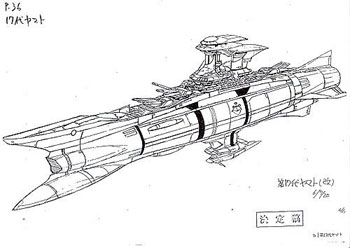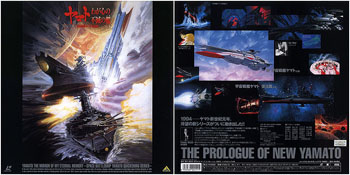SPACE BATTLESHIP YAMATO, Part 10 Author: Tim Eldred, Starblazers.com and Greasemonkeybook.com SPACE BATTLESHIP YAMATO, Part 1: The Anime Classic That Nearly Wasn`t SPACE BATTLESHIP YAMATO, Part 2: From Valley to Peak SPACE BATTLESHIP YAMATO, Part 3: ARRIVEDERCI YAMATO Goodbye Dark Ages, Hello Global Village SPACE BATTLESHIP YAMATO, Part 4: We`re Off to Outer Space SPACE BATTLESHIP YAMATO, Part 5: THE NEW VOYAGES Plural SPACE BATTLESHIP YAMATO, Part 6: BE FOREVER YAMATO...and the Kitchen Sink. SPACE BATTLESHIP YAMATO, Part 7: SPACE BATTLESHIP YAMATO III: The Ground Shifts SPACE BATTLESHIP YAMATO, Part 8: FINAL YAMATO: The Legacy Begins SPACE BATTLESHIP YAMATO, Part 9: Dessler`s War and More: SPACE BATTLESHIP YAMATO IN THE 80s As the nineties began, Yamato’s time in the wilderness appeared to be over. Producer Yoshinobu Nishizaki stopped dabbling in projects that didn’t repeat his past successes. Two non-Yamato movies (the anime space opera ODIN and a live-action teen romance called A PASSENGER) came and went with little fanfare. His video distribution company, JAVN, ended in bankruptcy and one of his business partners, Bandai, walked away with control of SPACE BATTLESHIP YAMATO on home video.
With the start of a new decade, the slate was wiped clean. From here on, it would be all Yamato all the time. A long and frustrating development phase had finally yielded up a story Nishizaki liked. It was suggested by writer Soji Yoshikawa (a veteran of the “real robot” craze of the early 80s with credits on DOUGRAM, VOTOMS, GALIENT, and more) that a jump to the future would provide the mojo to restart the franchise. Rather than resurrect the original Yamato, he thought it would be interesting to create a new ship 300 years later. The title was made immediately obvious: YAMATO 2520. Now freed up from having to work around past decisions, Nishizaki made a complete stylistic break by hiring American artist Syd Mead, famous for his contributions to cutting-edge SF movies such as BLADE RUNNER, TRON, and 2010. Mead took YAMATO and ran with it, designing highly streamlined ships and planetscapes. Even the hero ship, the eternal icon of SF anime, was not immune. Only the most rudimentary elements of its structure could be seen in the new version, which Mead built in CG on his home computer as he worked out its form and function. Pictures were released to the world as early as 1988 in the pages of the Yamato fan club magazine. There was no actual story yet, but after Nishizaki dug himself out of old business dealings (JAVN and the Yamato fan club both closed their doors in the summer of 1991) he started a new company called Voyager Entertainment with YAMATO 2520 as a top priority. (Incidentally, he bought back the rights to STAR BLAZERS from Westchester Films the following year and set up an American arm of Voyager to bring it back to life. That company continues to operate independently to this day.)
YAMATO 2520 was officially announced in 1993 after the story had been worked out in detail. In the decades following FINAL YAMATO, Earth`s greatest challenges came from within. The rise of genetically-enhanced humans lead to the threat of a fascist state. This threat was eliminated when these elites were exiled in a convoy of colony ships, and they made their way to another galaxy where they discovered a new source of tremendous power called Monopole energy. Their leader, Brone, founded the Salene civilization there and declared opposition to the Earth Federation. About a century later, another source of Monopole energy was found on the planet Rinbos, in a satellite galaxy of the Milky Way. Earth forces mobilized to excavate it, and when the Salene arrived to do the same, it sparked a war that raged for 100 years before both sides reached stalemate and a cease-fire was declared. Salene held onto Rinbos (now an independent frontier world) and Earth set up on the neighboring planet Agua to monitor them. It`s an extremely tense situation; if either side makes a threatening move (like going after the Monopole) the war could boil up again in a flash. This brings us to the year 2520, when the inevitable happens. But there’s more: sometime during the 100 Year Galactic War, a group of explorers from Earth called the Kodai Spacemen found evidence of an ancient civilization called the Goda. All they could decode was a single message stating that whoever controls their vast technology can control the universe. Space Battleship Yamato (the 17th ship bearing the name) found an element of that technology but was shot down over planet Rinbos. Using an ultra high-tech Salene shipbuilding plant, a group of teenagers recreate the ship and take off into the whirlwind of fate.
On the surface, YAMATO 2520 had everything going for it; a fresh story anyone could pick up on, unique designs and the promise of a 7-episode run on home video. But right from the outset, it was beset by problems that to this day have never been satisfactorily explained. For starters, it did not debut on time. Initially scheduled for 1994, Volume 1 was delayed and ultimately replaced by a documentary titled VOLUME 0: 100 YEAR WAR IN THE MILKY WAY. It took another two months for Volume 1 itself to arrive and fandom apparently greeted it with ambivalence. Volume 2 didn’t show up for another 10 months, by which time the writing was probably on the wall. Volume 3 took another 9 months to finish and was released in August 1996 with no mention of future volumes, which was a real shame because the story had picked up considerable energy by that point.
Where did it all go wrong? Production delays would definitely have been a major deficit, and disappointing sales would certainly have stifled funding from Bandai. Though hard evidence has yet to turn up, the most probable cause is the simplest one: fans just weren’t interested in a new YAMATO. They wanted to see the old one again. And that’s where the story takes an interesting twist. The world’s first detailed look at 2520 came in 1994 on a direct-to-video documentary titled THE QUICKENING. It commemorated YAMATO’s 20th anniversary and promoted not one but TWO new productions: YAMATO 2520 and YAMATO REBIRTH. Of the two, REBIRTH was by far the most intriguing since it would bring back the original ship and characters 17 years later (the year 2220 to be exact) at which time Earth is threatened by an approaching black hole. REBIRTH wasn’t as far along as 2520, but it had all the appearances of an active production for Nishizaki and his crew.
This timing was fatal. Had REBIRTH gone out ahead of 2520, it might very likely have met with greater acceptance and kept the ship of state on an even keel. Instead, the financial losses from 2520 were so great that Nishizaki had to declare bankruptcy and West Cape Corporation shut down forever in August 1997, one year after 2520 Volume 3 was released. This appears to have put him on a downward spiral. He was arrested in December of that year for possession of weapons and narcotics, arrested again 14 months later, and incarcerated in October of 2000. And this is where his story ends…for now. Fortunately for all of us, YAMATO’s story didn’t end with the closing of West Cape; not even close. Overall ownership of the property was now held by Tohokushinsha Film Company with Bandai as a major participant, and they were not about to let it go. In fact, they formed a three-way partnership in 1998 with the one man who was qualified to step into Nishizaki’s shoes, and the results had nearly the same impact as YAMATO’s famous comeback twenty years earlier. Read much more about Yamato and find STAR BLAZERS DVDs at www.starblazers.com STAR BLAZERS is ©Voyager Entertainment, Inc. Next time: The Leiji Matsumoto Renaissance: Yamato in the 21st Century








